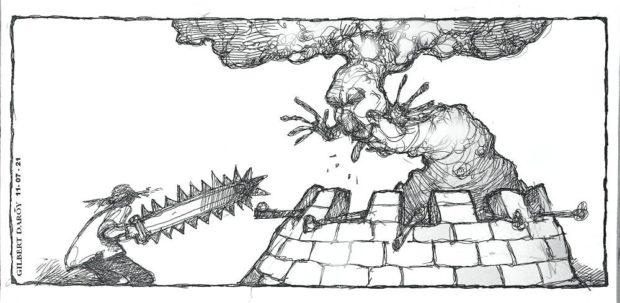Saving what’s left of our forests

The Philippines, together with more than 100 countries, signed early this week a landmark international agreement that vows to end deforestation by 2030 in a bid to slow global warming. But many environmentalists are skeptical as they feel the agreement is a rehash, and developing countries like the Philippines have to work double-time to meet their pledge by matching it with tangible action on the ground.
Indonesia, which together with Brazil and the Democratic Republic of Congo collectively account for 85 percent of the world’s forests, has already exposed the challenges ahead by protesting the zero-deforestation pledge and calling it “inappropriate and unfair” vis-à-vis its own development plans, particularly in the palm oil and nickel and electric vehicle industries.
“Forcing Indonesia to (reach) zero deforestation in 2030 is clearly inappropriate and unfair… The massive development of President Jokowi’s era must not stop in the name of carbon emissions or in the name of deforestation,” the country’s environment minister Siti Nurbaya Bakar wrote on Twitter last Nov. 3.
Under the Glasgow Leaders’ Declaration on Forests and Land Use, which was signed at the ongoing global climate summit in Glasgow, signatories must take transformative action in conserving forests. The agreement will incentivize the protection of forests, with wealthy states directing $12 billion toward tropical countries over the next four years in an effort to slow climate change; banks and private industry are expected to contribute $7 billion more to the undertaking.
The initiative will hopefully boost reforestation efforts in the Philippines, where the problem also involves the rights of indigenous peoples as well as the lack of protection for those who guard the country’s forests and natural resources. Last year, 29 land and environmental activists were murdered, according to human rights organization Global Witness, with logging as the main driver for most of the killings.
The country’s massive deforestation, per the Global Forest Watch (GFW), an online open-access platform that offers forestry data, has already resulted in the loss of 151,000 hectares (1.5 billion square meters) of humid primary forest, making up 12 percent of the Philippines’ total tree cover loss, from 2002 to 2020. In terms of tree cover, the country lost 1.29 million hectares (12.9 billion square meters or about the size of more than 22,000 Rizal Parks) from 2001 to 2020, equivalent to a 6.9-percent decrease since 2000.
GFW data also show that 11 regions were responsible for 51 percent of tree cover loss, led by Palawan, with 163,000 hectares (1.63 billion square meters) lost. The other top areas in terms of tree cover loss were Agusan del Sur (116,000 hectares or 1.2 billion square meters), Zamboanga del Norte (59,700 hectares or 597 million square meters), Davao Oriental (48,800 hectares or 488 million square meters), and Quezon (44,200 hectares or 442 million square meters).
Forests, according to the global research organization World Resources Institute (WRI), absorb 30 percent of carbon dioxide emissions, which account for 76 percent of total greenhouse gas emissions. Thus, protecting forests can help slow down temperature rise in the short term as they take the emissions out of the atmosphere and prevent them from warming the climate. But experts also warn that this has to be matched by reducing greenhouse gas emission levels from fossil fuels i.e., coal, oil, and gas. Under the Paris climate agreement adopted in December 2015, countries committed to limit global temperature rise to ideally 1.5 degrees Celsius.
The Glasgow zero-deforestation pledge is not the first: In 2014, 40 governments, again including the Philippines, signed the New York Declaration on Forests, which aimed to cut by at least half the rate of loss of natural forests by 2020 and end natural forest loss by 2030. Environmental science news platform Mongabay said the agreement failed to meet its objectives: “Instead, deforestation rose by nearly 20 percent among its signatories between 2016 and 2020.”
The new Glasgow pledge, however, has the backing of countries that “control some of the world’s most important forests, most notably Brazil, Russia, China, Indonesia, and the Democratic Republic of Congo,” indicating that heads of state now acknowledge that deforestation can no longer be ignored.
“When you look back over the past few decades of climate action, forests had been the Cinderella neglected stepsister,” said Frances Seymour, a distinguished senior fellow at the WRI. “Many of us who’ve been in this business for several decades have seen this movie again and again and again, and the ending never changes. Pledges are made and then nothing happens.” Will it be the same for the Glasgow deal, or will the world’s remaining forests finally get a break this time?




















